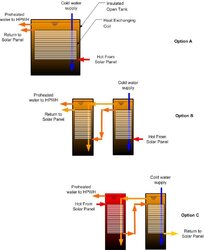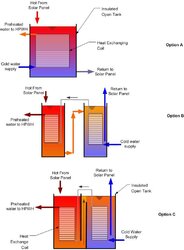I'm starting to scrounge parts for a solar water heating system and need some help thinking through my options. I plan to use an open tank design for heat storage and exchange and came up with a 3 basic alternatives (see diagram). All tanks are non-pressurized and use pressurized tubing for domestic water and heat transfer. The preheated water would then flow to our GeoSpring heat pump water heater (HPWH).
Option A - Single tank design - Bigger tanks are harder to find and move. Simpler overall design and plumbing would be minimized. Tank heat loss would be minimized.
Option B - Multiple tanks in series with hot water from collector entering near where cold supply water enters. It looks to me like this option is pretty much equivalent to Option A and both tanks would be roughly the same temperature. More plumbing, more heat loss.
Option C - Multiple tanks in series with hot water from the solar collector entering near where preheated water flows out to the HPWH. It looks to me like option would result in different tank temps and possibly less overall efficiency since temperature exchange rates are directly dependent upon temperature differential. However, having storage tanks at different temps might be an advantage for other applications such as hydronic heating. The bad: more plumbing, more heat loss, potential heat transfer efficiency loss.
I guess another option is multiple tanks in parallel. But that seems pretty straight forward to me. The only difference between that and a single tank would be increased heat loss and more plumbing to do, neither an advantage.
Thoughts?
Option A - Single tank design - Bigger tanks are harder to find and move. Simpler overall design and plumbing would be minimized. Tank heat loss would be minimized.
Option B - Multiple tanks in series with hot water from collector entering near where cold supply water enters. It looks to me like this option is pretty much equivalent to Option A and both tanks would be roughly the same temperature. More plumbing, more heat loss.
Option C - Multiple tanks in series with hot water from the solar collector entering near where preheated water flows out to the HPWH. It looks to me like option would result in different tank temps and possibly less overall efficiency since temperature exchange rates are directly dependent upon temperature differential. However, having storage tanks at different temps might be an advantage for other applications such as hydronic heating. The bad: more plumbing, more heat loss, potential heat transfer efficiency loss.
I guess another option is multiple tanks in parallel. But that seems pretty straight forward to me. The only difference between that and a single tank would be increased heat loss and more plumbing to do, neither an advantage.
Thoughts?





